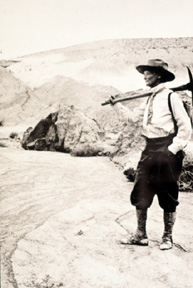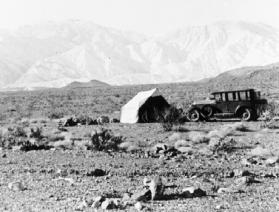Founder of the MVZ
Annie M. Alexander (1867-1950)

Annie Montague Alexander was born December 29, 1867, in Honolulu, Hawaii. She was a naturalist, an intrepid explorer, and an extraordinary patron at a time when women did not have the right to vote and few had any involvement with the world outside their homes. She founded both the Museum of Vertebrate Zoology (MVZ) and the University of California Museum of Paleontology (UCMP) on the Berkeley campus and was the benefactress of those museums for more than 40 years. The men she hired and whose research she funded, those whose careers were built on the specimens she collected, are generally well-known within the disciplines of vertebrate zoology and paleontology,
e.g., Joseph Grinnell, Alden H. Miller, E. Raymond Hall, John C. Merriam, and Charles L. Camp. Although she preferred anonymity, it was Alexander’s vision and her steadfast commitment to basic research that made possible the scientific contributions of these men.

In the fall of 1900, Alexander began attending paleontology lectures at
Cal being given by John C. Merriam. Her passion for the subject was immediately ignited and she began contributing specimens to the University’s collection. Her knack for locating important fossil specimens proved extraordinary. She also began providing money for field work and, in 1905, she created a separate fund for such work at the University.
By 1903, she had also begun collecting specimens of living vertebrates. Alexander was aware that many of the large, terrestrial mammals (e.g. grizzly bear, antelope) were disappearing in California, succumbing to the ever-increasing population growth of the state. She also realized that much indigenous flora and fauna was disappearing elsewhere as well. If a complete and accurate record of the fauna was
to be made for posterity, work would have to begin at once.
In writing to C. Hart Merriam in 1906 about her upcoming trip to Alaska, Alexander first laid out her plan for creating the MVZ. It was her hope that such a museum would aid paleontologists on campus by providing comparative material for research, that it would house a complete and accurate record of the West Coast fauna for posterity, and that it would stimulate interest in natural history among the general public. Public education, she hoped, would lead to conservation of all the flora and fauna about which she cared so deeply.
Alexander’s commitment to her museums manifested itself through field work which enlarged their collections. In addition to contributing thousands of specimens to the Paleontology and Vertebrate Zoology museums, Alexander also deposited nearly 6,000 plant specimens in the University and Jepson Herbaria on campus. Alexander would camp for weeks and months at a time, often in winter under harsh conditions. She continued collecting and doing field work until her death in her early 80’s. On her 80th birthday, she was collecting in Baja California.

While Alexander was not herself a scientist, it was her vision, her money, the specimens that she collected, and her financial and political acumen that created the natural history museums on the Berkeley campus and that permitted men like Joseph Grinnell and John C. Merriam to achieve distinction in their disciplines. Alexander’s sense of fulfillment in her vision is evidenced in this excerpt of a letter she wrote to Grinnell in 1926,
“I am gratified that the Museum has its contribution to make to the solution of the great problems of evolution. That is the ultimate, if not the only goal, is it not, of our special kind of scientific work?”
